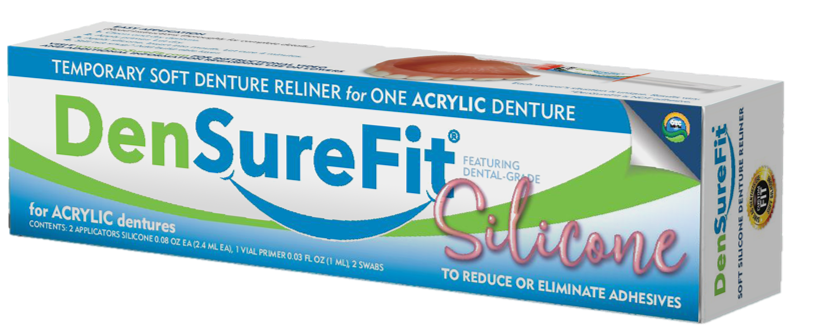Getting dentures is the best way to preserve your sense of confidence, security, and freedom after you lose your teeth. However, the process of having your teeth removed and then finding that perfect denture fit can be slow and sometimes troublesome. In this article, we will explore three ways to get the most out of your new dentures and the pros and cons of each one. When you are done reading, you will know-how to go about choosing the best course of action for you to get a comfortable fitting, well-functioning dentures. But first, let’s look at the cause of the problem or why your dentures might not be fitting well and causing you pain or discomfort.
- You may not have formed enough new tissue where your teeth used to be. Please allow at least 2 weeks after the initial extraction for these delicate tissues to form before trying to wear dentures.
- In the 12-18 months after your extraction, your gum line continually changes as your healing progresses, and your swelling goes down. You will need to constantly adjust the fit of your denture over this time period to fit the changing contours of your mouth.
A lot of changes will occur right after your teeth have been pulled out. The now-empty sockets, where your teeth used to be, will begin to fill up with new tissue and start to form a new gum line. During the first stages of healing when new tissue is still forming you will see slight indentations where your teeth used to be. In time those indentations will heal and disappear. Depending on the size of the tooth the healing period will vary. The smaller diameter teeth sockets (where your incisors used to be) will tend to heal faster than your larger diameter teeth sockets (where your canines and premolars used to be). All of this means that your gum line will be constantly changing during this period. At the same time, your hard acrylic dentures won’t change. This is what causes problems with the fit. Even after the initial healing, like every part of the body, the structure of your mouth will naturally change. While these changes will be slight and hard to see, you will notice a difference if how your dentures fit over time.
Several factors can affect these changes:
- How well you take care of your oral health.
- Your age.
- What products you have been using with your dentures.
All of these changes mean one thing. Your dentures will always need fine-tuning in order to ensure you get the perfect fit! Okay now that we have looked at why your dentures may not befitting all nice and snug look at all the ways you can correct that.
Option One: Using an Adhesive With Your Dentures
For a lot of people using an adhesive alongside their dentures is the go-to solution
when the fit is not quite right or they require a bit of extra security.
The adhesive is applied directly to your denture and creates a bond between the denture and your gums. It comes in a few varieties in the form of powder, gel or cutaway strips. Now let’s look at the pros and cons of using it:
Pros:
It’s cheap – You can get a tube of adhesive for as low as 5 dollars. And that’s pretty much where the pros end. Sorry if you were expecting more but you get what you pay for and in this case, you really didn’t pay a lot.
Which brings us to the…
Cons:
It’s not comfortable and can cause dental pain – By gluing the hard acrylic denture plate directly to the soft tissues of your gums and palate, you can create pain and discomfort when you chew or bite down. There is no cushioning effect with adhesives.
It’s a hassle – Using a denture adhesive requires a lot of maintenance. Every day you will need to thoroughly clean out the denture and apply a new layer of adhesive. This step should not be skipped because leftover adhesive will prevent the new layer from getting a good stick. Also, it will encourage bacteria growth in the gaps between your dentures and your gums. This may lead to bad breath, or even worse, infection.
It may alter how your food tastes – While the chemicals in the adhesive make your denture more secure they may also cause numbing of the taste buds. This is a major problem because after all, you should be able to comfortably enjoy the taste of your favorite food.
Excessive use of adhesives can be downright dangerous –
Most denture adhesives use zinc. Zinc in small doses does not pose a threat to the human body however, the prolonged use you will start needing more and more products to get the best-fit dentures. More product means more zinc is getting into your body this can cause a host of issues from bone receding to nerve damage.
Option Two: Applying a Soft Reline Product at Home
As we mentioned at the beginning of the article there will always be some gaps between your denture and your gums. A soft reline is a product you apply to your denture to create a custom fit that is both secure and comfortable. There is a variety of soft reline kits available in the stores that use methacrylate – a plasticized powder that you mix with a liquid to create a thermo-reactive putty that looks like used bubblegum. It has a strong smell and taste that is similar to fingernail polish remover and can burn your mouth. For the best fitting soft reline, choose a silicone-based product that will create a soft cushion against your gums, lasts up to 3 months, and won’t crack or break. Silicone is also tasteless and odorless.
Pros:
Bang for the buck – While soft reline products are generally more expensive than adhesives, they provide way more comfort and security for your denture.
Easier to use – There’s no need to apply or scrape off adhesive because you will need little or no adhesive with a soft reline. cleaning your dentures every day, applying and reapplying product constantly, forget about that. A soft reline should last you months.
No foul taste in the mouth – This will depend on the product. Make sure you are buying a silicone-based reline. This way the food will taste just the way it should. It also won’t interfere with saliva glands as adhesives do. With a reline you will be able to break down foods properly when you chew.
Acts as shock absorbent – Your gums are made out of soft tissue. This tissue will move and react to what's happening in your mouth while your dentures are hard and won’t move. This may cause friction which in turn causes irritation and discomfort. In this case, the soft reline will act as a protective cushion between the soft gums and the hard dentures. Imagine it like a mattress for your mouth.
Cons:
Highly dependant on the type of product – All the soft reline products available in stores are made of methacrylate. They are cheaper than silicone relines and don’t provide the same quality fit, or long-lasting the comfort of a silicone reline product. Cheap out and you will see none of the benefits and introduce a lot of cons. That’s why it is essential to do proper research about what you are buying before making the investment. The only Over-The-Counter (OTC) soft reline with silicone available on the market is Densurefit. You can’t buy it in stores because it is ONLY available online at densurefit.com. The only other way you can get a silicone-based soft reline is by going to your dentist.
Option Three: Going to the Dentist for a Soft Reline
Out of all the methods, this one is the simplest. Just go to your dentist and you don’t have to worry about a thing. He or she is an experienced professional who knows what they’re doing.
Pros:
You are in the hands of a professional – Your dentist has probably made hundreds if not thousands of dentures, soft and hard relines. He will immediately spot any problems that may occur and prevent them, saving you a lot of unnecessary pain and expenses.
Cons:
You will pay more – You can pay from 200 to 300 dollars for a soft reline while a good product that you can apply yourself will cost you around $50 – $60 dollars. Consider that you may need to do this at least 4 times a year and the cost to you skyrockets. For some people, this is simply not an option.
Some dentists use methacrylate in their soft relines –
Before signing up for a soft reline, ask your dentist if the soft reline product is made of silicone. If not, ask him or her if it tastes or smells like fingernail polish. If they say yes, ask them to use a silicone reline material instead.
Here is what we recommend
Get Densurefit. It is a professional-grade silicone-based soft reline product you can use in the comfort of your home.
Here is what we recommend
Get Densurefit. It is a professional-grade silicone-based soft reline product you can use in the comfort of your home.


